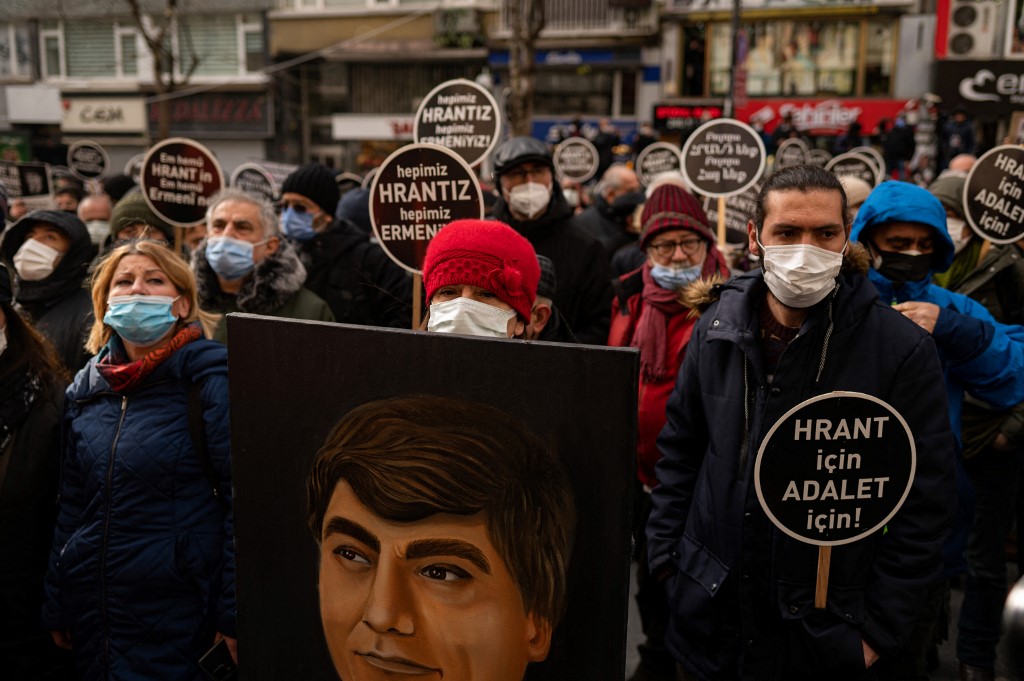Hundreds of people gathered outside the former offices of the Agos newspaper in İstanbul to commemorate Turkish-Armenian journalist Hrant Dink, who was murdered 15 years ago, local media reported on Wednesday.
The 52-year-old Dink, editor-in-chief of the Turkish-Armenian bilingual Agos weekly, was shot dead with two bullets to the head in broad daylight outside the newspaper’s headquarters in Şişli on Jan. 19, 2007, by a then-17-year-old jobless high-school dropout.
His murder sent shockwaves across the country and left a lasting mark on Turkish society because he had been a leading advocate for Turkey’s democratization and for reconciliation between Turks and Armenians.
This year, the journalist was commemorated in an event attended by hundreds of people, including Dink’s family and friends and a number of opposition politicians, who gathered in front of the former offices of the Agos newspaper.
The slain journalist’s wife Rakel Dink, children Arat Dink, Delal Dink and Sera Dink, brother Yervant Dink, pro-Kurdish Peoples’ Democratic Party (HDP) MPs Garo Paylan, Hüda Kaya and Ömer Faruk Gergerlioğlu, Republican People’s Party (CHP) İstanbul Provincial Chair Canan Kaftancıoğlu and vice chair Gökçe Gökçen were among those who attended the event.
A giant picture of Dink was hung outside the former Agos building, reading “15 missing years.”
Following a moment of silence to honor Dink, the crowd chanted, “We’re all Hrant, we’re all Armenian.”
Speaking during the event, Rakel Dink said: “It’s been 15 years. … The children of those days are growing up now. [And] we’re putting every problem we have failed to solve on their shoulders. … They’ll have many more problems [besides Dink’s murder]. … [So], let’s unlock [the mysteries of] the past so that anguished souls can be freed.”
Dink’s murder, the masterminds of which remain unknown to this day, became a wider scandal after judicial proceedings showed that a number of state officials, including then-İstanbul police chief Celalettin Cerrah, were long aware of an assassination plot but failed to act.
Dozens of people have been accused of involvement in the murder in the last 15 years, and a series of trials were held without a clear and satisfactory conclusion because links between hitman Ogün Samast and officials in the police and intelligence agency have proven to be complex and subject to political manipulation.
The Turkish General Staff on Feb. 22, 2004 released a press statement targeting Dink over a report that claimed Sabiha Gökçen, the adopted daughter of Turkey’s founder Mustafa Kemal Atatürk, was Armenian. The military said Dink’s assertions were “unhealthy” and “dangerous” and called on the relevant authorities to act.
He was convicted of “insulting Turkishness” due to opinion pieces he wrote after a series of hearings in 2005, over which Dink received death threats and faced multiple attempts of physical assault. His sentence was approved by the Supreme Court of Appeals a year later.
A week before he died, the journalist wrote a piece titled “Why was I chosen as a target?” and detailed the attacks and threats he faced, including racist protests in front of Agos headquarters and criminal complaints filed against him.
Regarding Dink’s murder, the European Court of Human Rights (ECtHR) ruled in 2010 that Turkey had failed to protect him, violating his right to life.
In October Turkey’s Council of State upheld an administrative court decision ordering the Interior Ministry to compensate Dink’s family in the amount of 1,066,000 lira ($78,725) for failing to take necessary measures to protect Dink’s right to life.
